9 Rosemary Plant Care Mistakes You Should Avoid
Avoid common pitfalls with this guide to 9 rosemary plant care mistakes you should avoid. Learn how to prevent overwatering, poor sunlight exposure, and soil issues that stunt growth. With the right balance of light, water, and pruning, you’ll keep your rosemary thriving, fragrant, and healthy all year long.
Watering Like It’s a Fern
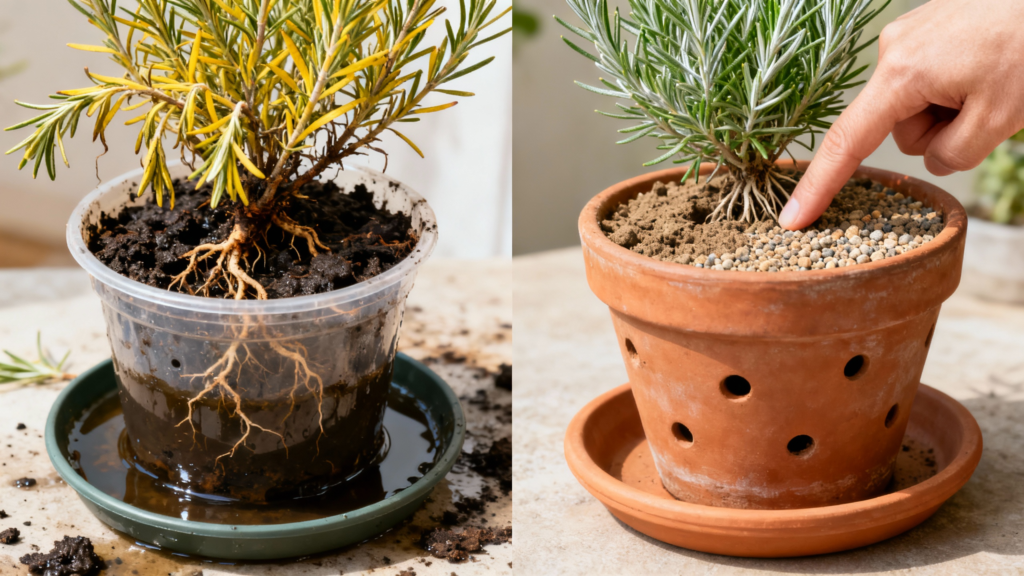
You love your plants, so you water them.
Great. But rosemary doesn’t do clingy. It hates soggy soil and wet feet. Rule of thumb: Let the top 1-2 inches of soil dry out before watering again.
Stick your finger in the soil—if it feels damp, wait.
- Use a pot with drainage holes. No exceptions.
- Empty the saucer. Standing water = root rot.
- Watch for signs: Yellowing leaves and a general droop usually mean overwatering.
How often should you water?
Outdoors in summer, maybe once a week. Indoors, every 10–14 days. It depends on your climate, pot size, and light.
When in doubt, under-water slightly rather than overdo it.
Planting in Heavy, Dense Soil
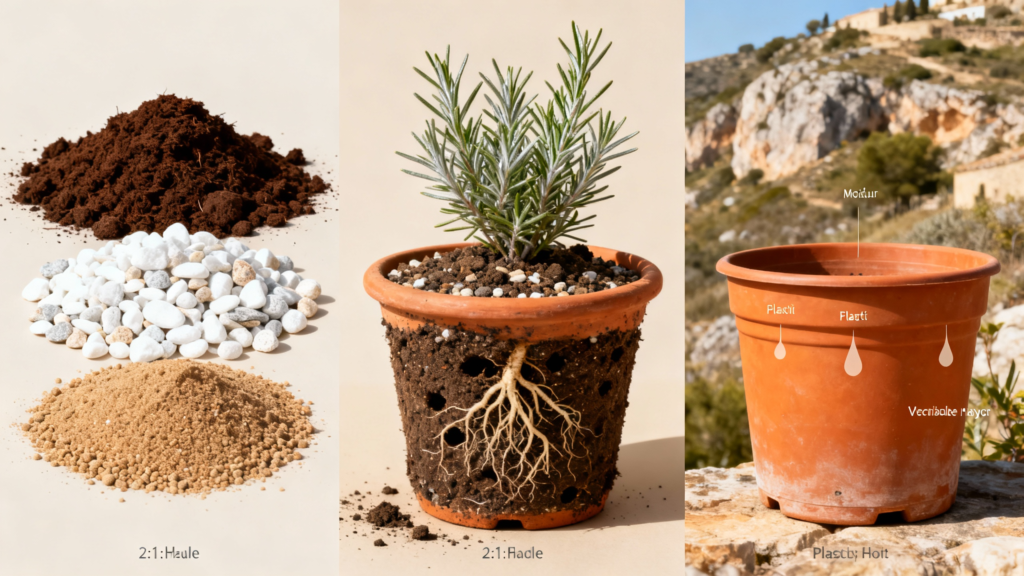
Rosemary comes from rocky Mediterranean hillsides, not swampy backyards. It wants gritty, fast-draining soil. Best mix for pots: 2 parts high-quality potting mix + 1 part perlite or pumice + a handful of coarse sand. That keeps roots happy and air moving.
Terracotta > Plastic (IMO)
Terracotta breaths and lets moisture escape.
Plastic traps water longer. If you tend to overwater, terracotta gives you a little safety net.
Putting It in the Dark
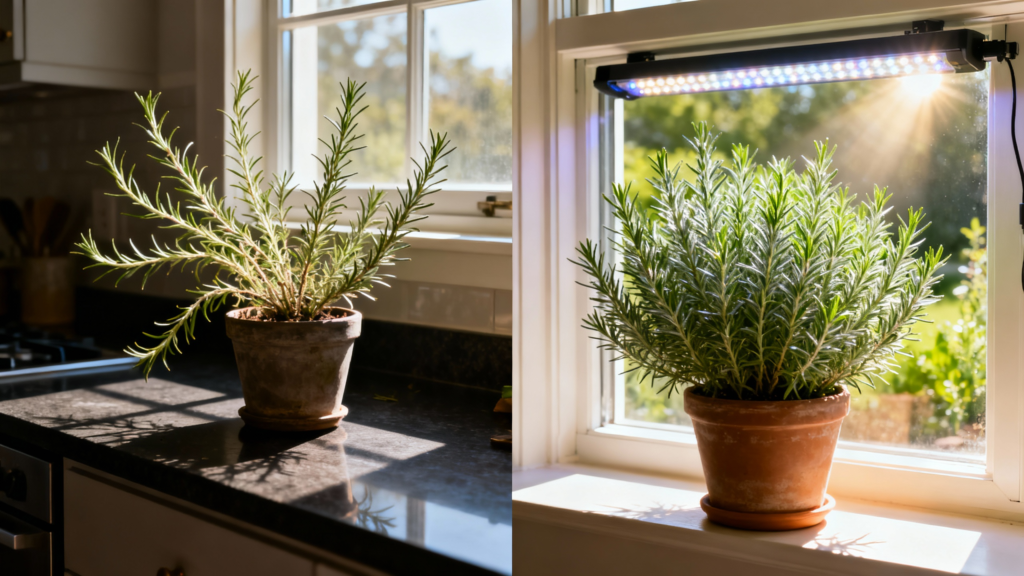
Your kitchen counter might look cute, but rosemary needs serious sun. Not “bright-ish.” Actual sun.
Think 6–8 hours daily.
- Outdoors: Full sun.
- Indoors: A south-facing window or a grow light for 10–12 hours daily.
If stems get long and floppy with big gaps between leaves, that’s classic “I need more light” drama.
Grow light basics
Use an LED grow light 6–12 inches above the plant. Keep it on a timer. FYI, cheap desk lamps don’t cut it unless they’re bright and close.
Letting It Freeze (or Sweat)

Rosemary can handle some chill, but not ice-cold winds or deep freezes—unless you have a hardy variety.
On the flip side, indoor heat blasts can crisp it up fast.
- Cold tolerance: Many varieties tolerate down to about 20°F (-6°C) with protection. Hardy types can go lower, but don’t push it.
- Indoors in winter: Keep away from heater vents and drafty doors.
- Acclimate: Move plants indoors before the first frost and give them the brightest spot you have.
Ignoring Airflow

Stagnant air invites powdery mildew and general grumpiness. Rosemary loves a light breeze.
- Space plants: Don’t cram pots together.
- Use a fan indoors: A gentle oscillating fan does wonders.
- Water the soil, not the leaves: Wet foliage + low airflow = disease party.
Feeding It Like a Tomato
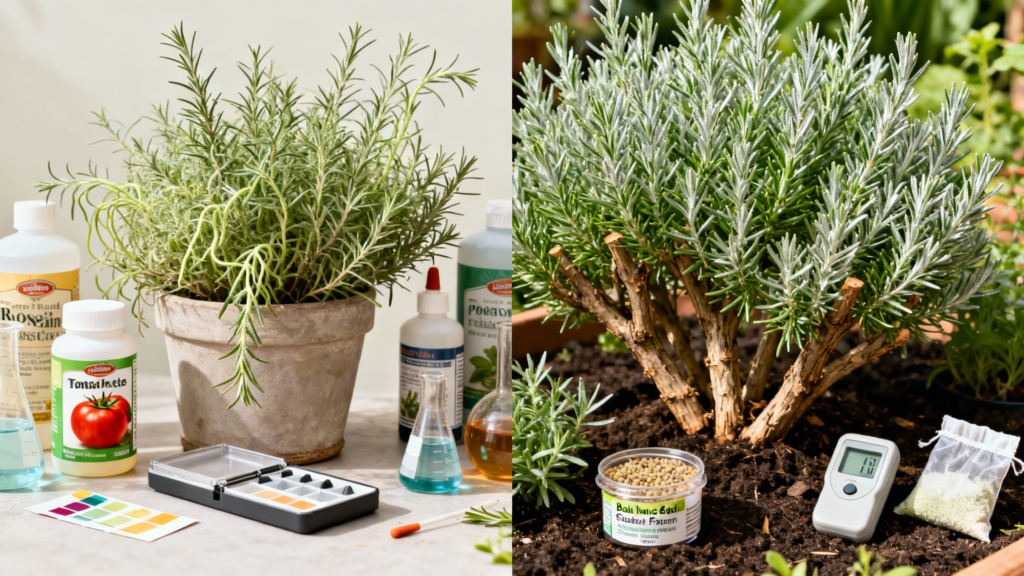
Overfeeding can make rosemary soft and weak, like that friend who drinks only smoothies.
It doesn’t need much fertilizer. Minimal feeding plan: In spring, give a light dose of balanced, slow-release fertilizer or a diluted liquid feed once a month through summer. Then stop. Honestly, some folks never feed and grow gorgeous plants.
IMO, less is more here.
Soil pH matters (a little)
Rosemary likes slightly alkaline to neutral soil (pH ~6.5–7.5). If your soil runs very acidic, add a bit of garden lime. Don’t go full chemistry set—just tweak if growth seems stunted.
Skipping Pruning (Or Going Edward Scissorhands)
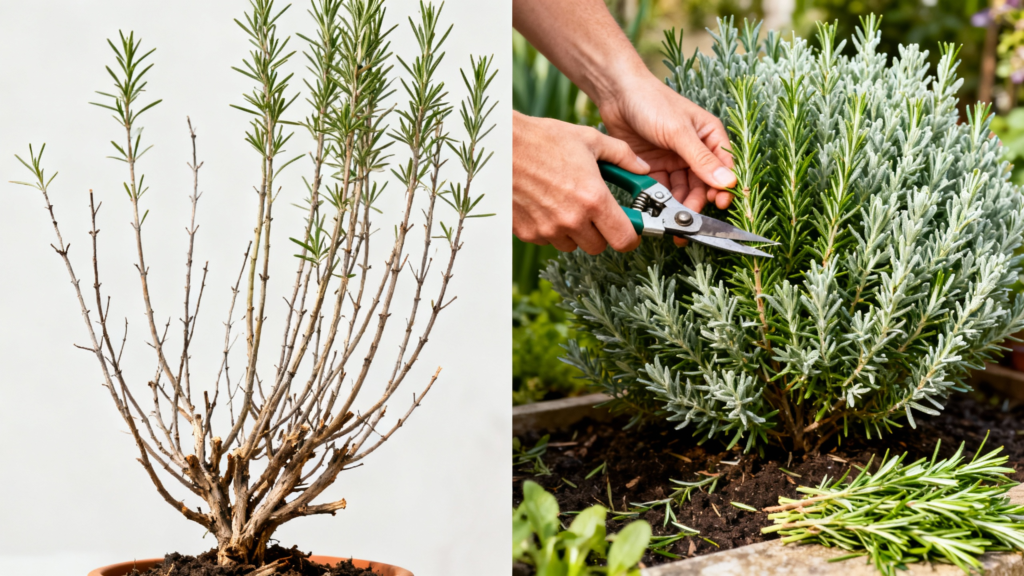
Pruning keeps rosemary bushy and flavorful.
The trick? Consistency and timing.
- Light, regular snips: Pinch or cut soft tips often to encourage side shoots.
- Don’t cut into old woody stems: It won’t regrow from dead wood.
- Major haircut: Do a moderate shaping in spring after the plant wakes up.
Harvesting without hurting
Cut 4–6 inch sprigs from various spots around the plant. Leave at least one-third of growth in place so it keeps chugging along.
Win-win: fresh rosemary and a fuller plant.
Using the Wrong Pot Size
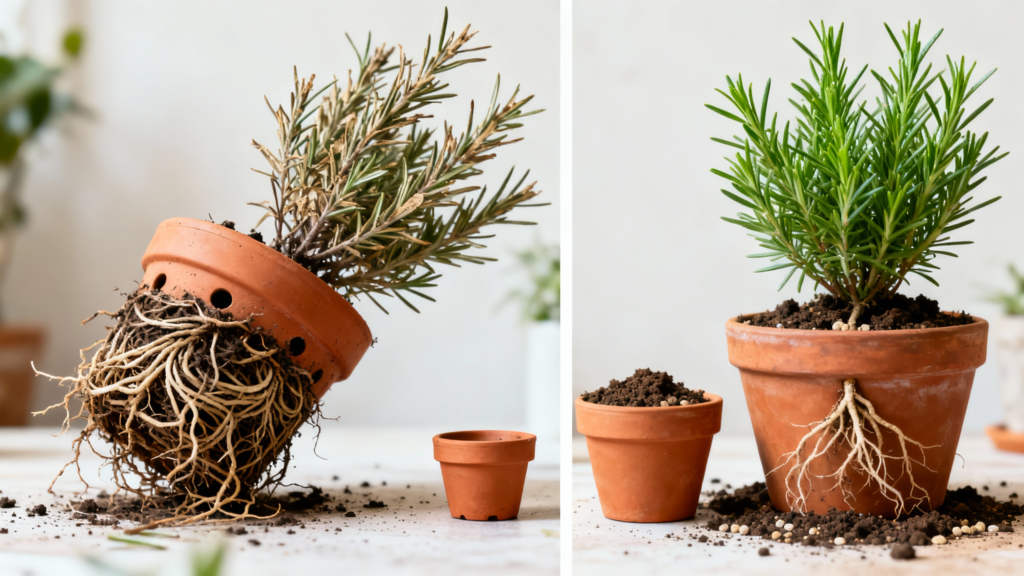
Tiny starter herbs look adorable, but they outgrow those cute pots fast. Cramped roots dry out in a blink and struggle to take up nutrients.
- Repot when roots circle the bottom. Go up 1–2 inches in diameter, not a giant jump.
- Choose a wide, stable pot. Rosemary grows top-heavy and can tip.
- Refresh the mix: New, gritty soil boosts drainage and airflow around roots.
Forgetting Varieties Aren’t All the Same
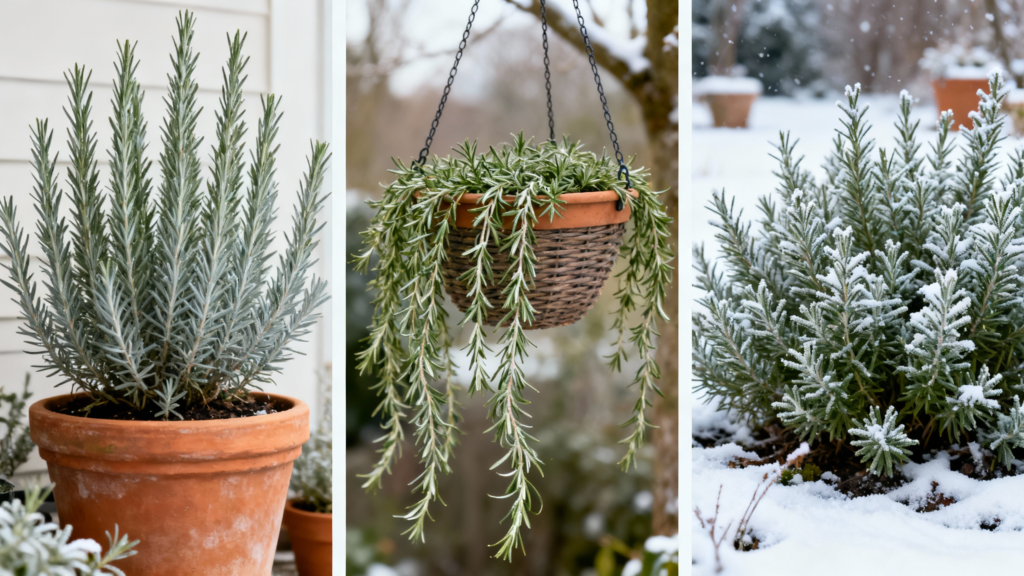
Not all rosemary behaves identically. Some stand tall like soldiers; others spill and creep.
- Upright types: Great for hedges and bigger pots (e.g., Tuscan Blue, Arp).
- Prostrate/creeping types: Perfect for hanging pots and groundcover.
- Cold-hardy picks: ‘Arp’, ‘Hill Hardy’, and ‘Madeline Hill’ handle colder zones better.
Bonus: Propagate for backups
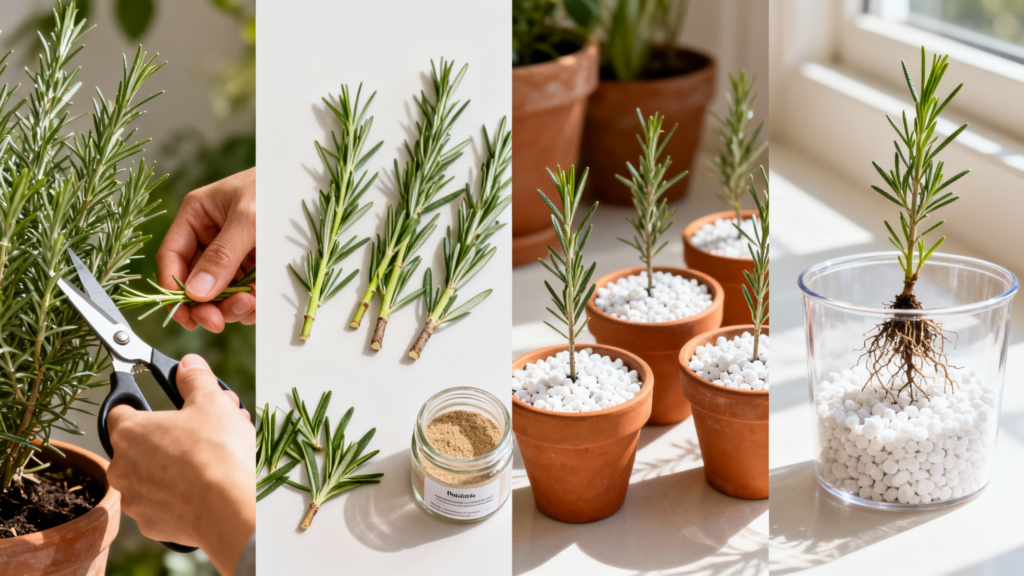
Take 3–4 inch cuttings from soft growth, strip the lower leaves, dip in rooting hormone (optional), and stick in a perlite-heavy mix.
Keep warm and bright, not soggy. You’ll have clones in a few weeks—basically rosemary insurance.
FAQ
Why does my rosemary keep turning brown at the base?
That usually screams overwatering or poor drainage. Check the pot’s drainage holes, lighten the soil with perlite, and space out waterings.
Also make sure it gets plenty of sun and airflow—shaded, damp bases tend to brown out.
Can I grow rosemary from grocery-store sprigs?
Yes, if they’re fresh and still pliable. Trim the bottom, remove lower leaves, and root in water or a gritty mix. You’ll get better success rates with a humidity dome or plastic bag, but vent daily to avoid mildew.
How much sun does rosemary need indoors?
Aim for a bright south-facing window with 6+ hours of direct light.
If that’s not happening, use a grow light for 10–12 hours daily. Without this, it gets leggy and sad fast—FYI, windowsills in winter often won’t cut it.
What pests should I watch for?
Spider mites, aphids, and the occasional whitefly. Rinse the plant, increase humidity slightly around it (but don’t soak the soil), and use insecticidal soap or neem.
Keep airflow strong—pests hate wind, and your rosemary loves it.
Is rosemary safe for pets?
Generally, yes. It’s considered non-toxic to cats and dogs in small amounts. That said, munching a whole plant can upset tummies, and essential oils concentrate the compounds—so keep those away from pets.
Should I bring outdoor rosemary inside for winter?
If your winters dip below the plant’s tolerance, bring it in before frost.
Place it in your brightest spot, reduce watering, and run a fan occasionally. It might sulk a bit but should perk up again in spring.
Conclusion
Rosemary thrives when you treat it like the sun-loving, drainage-obsessed diva it is. Give it bright light, gritty soil, decent airflow, and light hands with water and fertilizer.
Prune regularly, repot thoughtfully, and pick a variety that suits your climate and style. Do that, and your “impossible” herb turns into the easiest, best-smelling plant in the house—IMO, worth every sprig.
